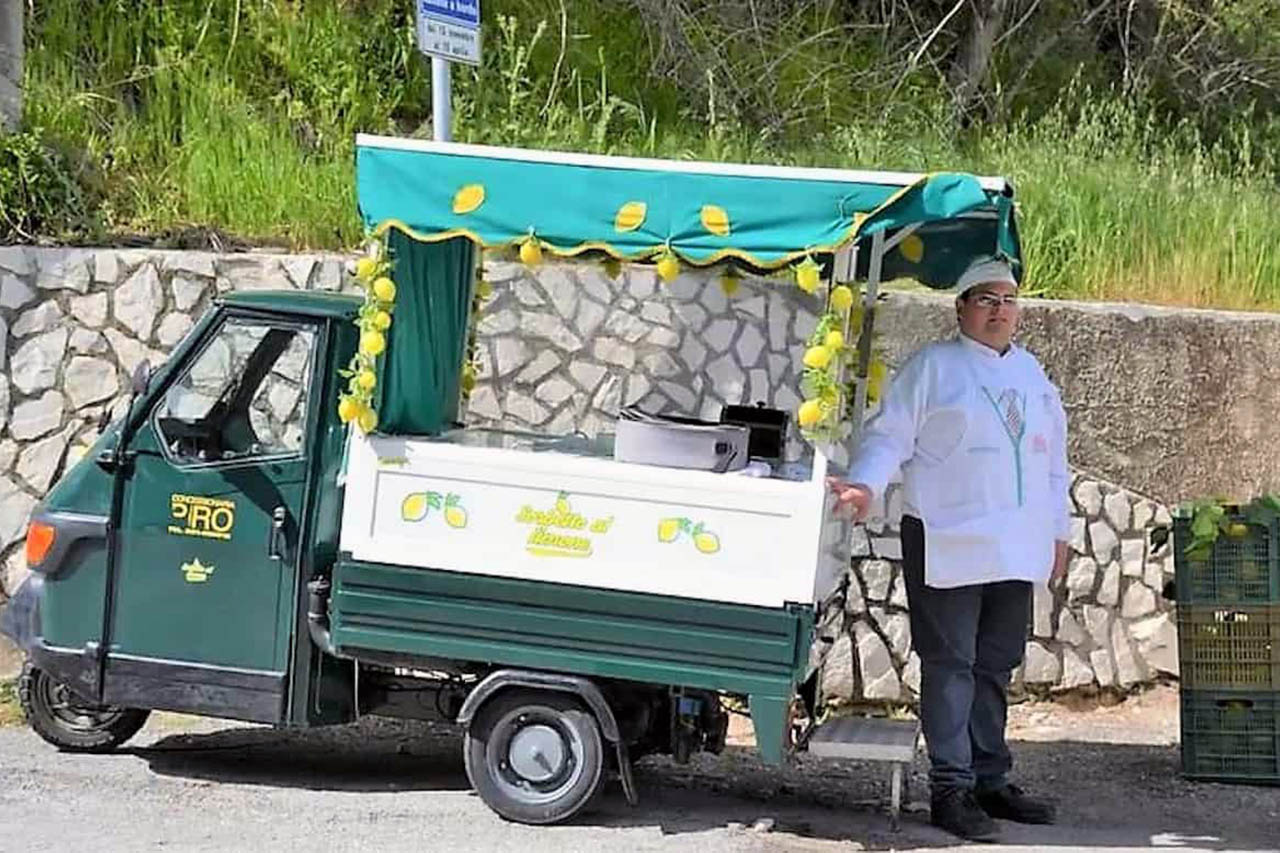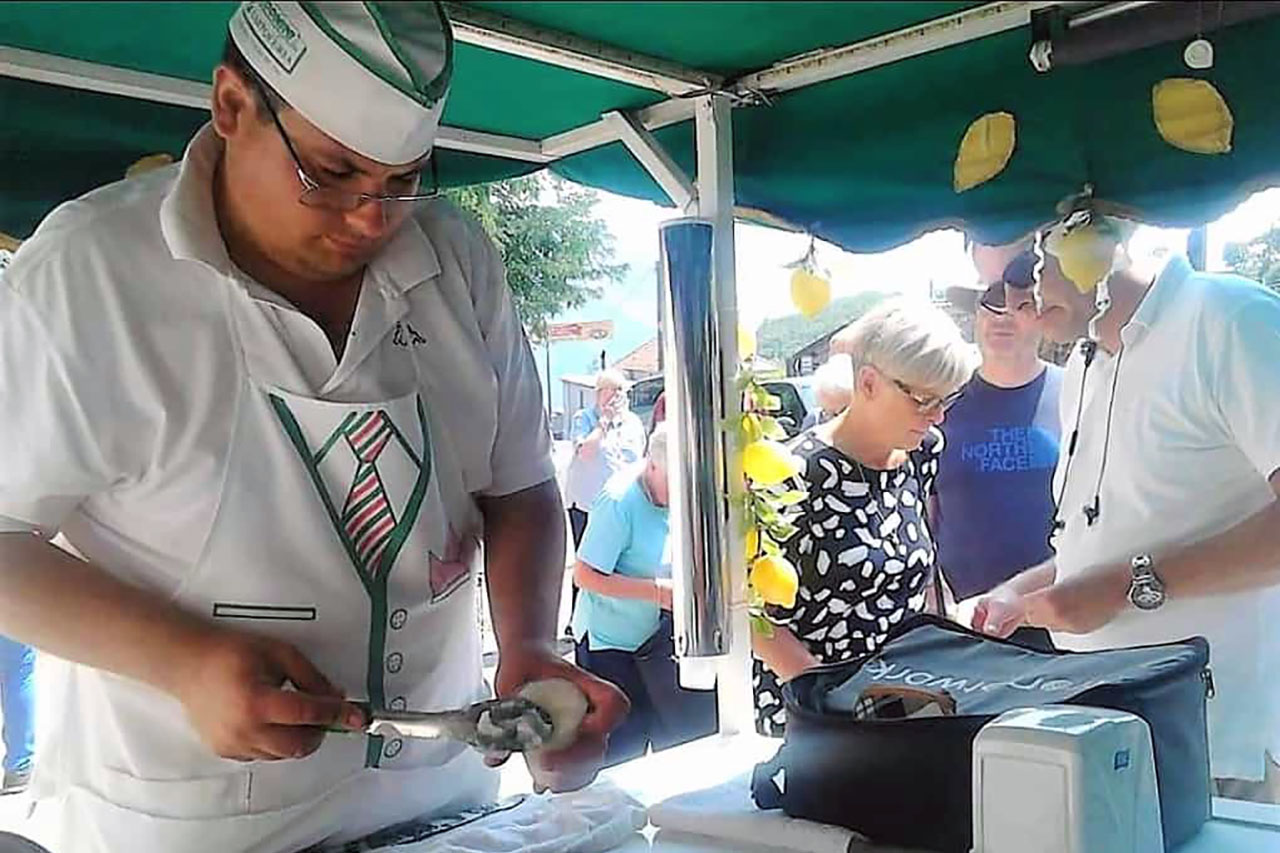Thanks to his father, Antonio, Attilio Di Lieto carries on an ancient craft that could disappear if not recovered.
April 3rd, 2022. By Annamaria Parlato
No precise address, geolocation, or GPS can identify it. It is enough to say: “See you at Valico di Chiunzi for a lemon sorbet,” and that’s it.
At 656 meters above sea level, precisely at the Valico di Chiunzi, the famous Lattari Mountains crossing path that connects the Agro-Nocerino-Sarnese area with the Amalfi Coast, you can taste the best sorbet in the entire province of Salerno: the one made by Attilio Di Lieto, the last sorbet-maker of Tramonti.

Who is the sorbet maker?
The sorbet maker was a widespread profession in Naples. Of ancient origin, already the Arabs had introduced Sicily the “sherbet,” an iced, sugared, and spiced beverage. During the Spanish invasion of Naples, there were numerous sorbet makers in the Viceroyalty, especially at the end of the seventeenth century and until the eighteenth century.
These people used the snow in the so-called “nevere or neviere” to create the refreshing sorbet sold in the streets. With this clean snow, they could mix different ingredients to give the sorbet the desired taste, even if the most common was lemon.
The sorbet was then kept in a copper casserole and carried around by the sorbet maker, on a cart, or by hand, from which he served the clientele.
Sorbet, the ancestor of ice cream
Sorbet is the ancestor of ice cream, with a beautiful texture based on water and fruit, sometimes syrups, essences, or liqueurs. Greeks and Romans already knew it. The Greek poet Simonides was the first to talk about it, emperor Nero loved it, and it was even described in Seneca’s texts. However, it was the Arabs, who arrived in Sicily in the ninth century, that used to consume it first.
Between the sixteenth and seventeenth centuries, it became very fashionable in the Italian courts, particularly in Florence, by the Medici family, and then among the bourgeoisie, thanks to the progress of technology and the construction of advanced machines to produce it.
The perfect consistency of a good sorbet must not be too liquid or solid. It is not by chance that this dessert is peculiar to being a semi-liquid dessert, halfway between ice cream and a fresh beverage. The lack of ingredients of animal origin and the generous quantity of fruit, at least 50%, make sorbet one of the lightest and most refreshing desserts of all, an ally of digestion, especially when consumed between meals.

The magic ingredient for a good sorbet: the Sfusato Amalfitano lemon
Lemon (citrus limonum or Limon), a plant belonging to the Rutaceae family, is native to tropical Asia and is cultivated in temperate Mediterranean regions. In Italy, the cultivation of lemon is widespread in the South (Campania, Calabria, and Sicily).
The name of the variety Sfusato Amalfitano, which gives rise to the Protected Geographical Indication “Limone Costa d’Amalfi,” is reserved for lemons that meet the conditions and requirements established by EEC Regulation No 2081/92 and the specification.
The production area of “Limone Costa d’Amalfi” includes the whole territory of the municipality of Atrani; part of the territory of the municipalities of Amalfi, Cetara, Conca dei Marini, Furore, Maiori, Minori, Positano, Praiano, Ravello, Scala, Tramonti, Vietri sul Mare. It was the Arabs who introduced the lemon in Spain and Sicily and from here in Campania. But the spreading of lemon in Amalfi took place thanks to the necessity of having this fruit after discovering its usefulness in the fight against scurvy. In the eleventh century, the Maritime Republic of Amalfi decreed that supplies of these fruits were always on ships.
After the sixteenth century, the presence of lemon is reported by many authors. In a text from the seventeenth century, there is also a mention of a “lemon amalphitanus,” with characteristics very similar to the modern Sfusato. The Amalfi Coast lemon is not just a simple crop. It is an element of the rural architecture of the coastal territory. It is a medical remedy that purifies the organism and regenerates the body.
Decisive properties of the product are the tapered shape of the fruit, from which the term “sfusato” derives, medium thick skin, light yellow color, intense aroma, and perfume due to the presence of essential oils, juicy and moderately acid pulp, with little presence of seeds.
The typical terraced cultivation along the steep slopes of the Coast, with the coverage of the plants through the famous “tagliatelle,” replaced by the more practical shading nets, helps to give those unique and valuable characteristics to the “Limone Costa d’Amalfi” PGI and to make its legendary “gardens” famous all over the world. The harvesting in the typical terraces is carried out from February 1st to October 31st and must be done by hand. It must prevent the lemons in the ground.
Attilio’s recipe: water, sugar, lemon, and a lot of passion
Attilio is a sorbet maker (in dialect intosta acqua), but his father, Antonio, was a sorbet maker before him. From spring to October, Attilio, as a street vendor with his tricycle, positions himself in a lay-by at the traffic circle of the Valico di Chiunzi or the most. He goes a few kilometers further down to Maiori. He waits for the customers who, in large numbers, create their queue to pick up a genuine glass of fresh and fragrant sorbet.
This sorbet is unique because it contains all the essences of Sfusato Amalfitano. It also includes the zest of the lemon, which is very pleasant to chew and palatable. Attilio shyly said: “I have been making sorbets for a few years now, using water, sugar, and lemons as ingredients. I replaced my father, who gave me the same passion and energy. This is now a seasonal job that allows me to meet people of different nationalities. Here I have everything I need. Sometimes I am also contacted by catering and banqueting companies. I am happy because the tradition will continue this way, and this craft will not disappear. I hope to pass it on to other enthusiasts”.
The solution composed of water, sugar, and lemon juice is collected in a steel container made of copper. The past is then put in water, ice, and a salt basin. The sorbet maker produces the sorbet at the moment using only centrifugal force. By making the container whirl, the liquid rises the walls and solidifies due to centrifugal force, becoming very soft snow. The secret is just this: a lot of goodwill and sacrifice is repaid by the affection of the people who have become accustomed to Attilio. The sorbet at the Valico is a must of the summer on the Amalfi Coast. It is a glass of happiness among the smiling hills of Tramonti.

